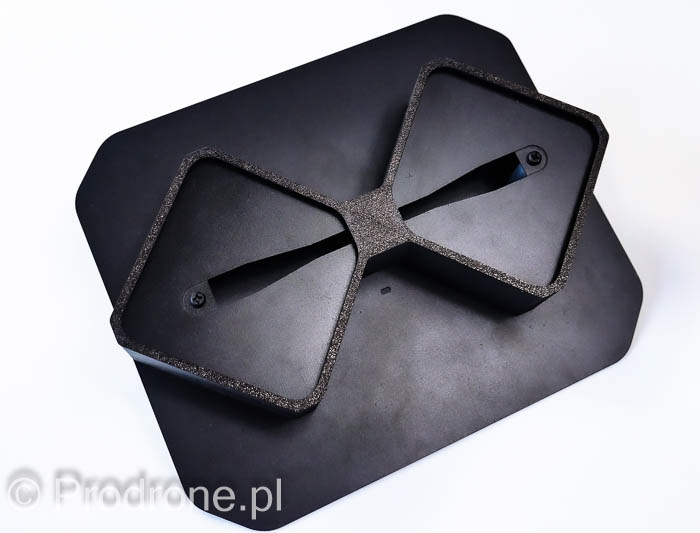If you’ve been in the FPV or amateur radio community for any length of time, you’ve probably heard heated debates about antenna selection. Today, we’re cutting through the noise to explore why biquad antennas have become the go-to choice for operators who need reliable, long-range performance at 1.2 GHz – and why our latest 10.5 dBi model might be exactly what your setup needs.
Understanding the Biquad Advantage
First, let’s address the elephant in the room: what makes a biquad antenna special? Unlike omnidirectional antennas that spray signal in all directions (wasting precious power), or complex yagi arrays that can be cumbersome to deploy, the biquad hits a sweet spot of performance, practicality, and price.
The biquad design consists of two connected square loops, each approximately a quarter wavelength per side. This elegant geometry creates a directional radiation pattern that focuses your signal where you want it while maintaining a relatively compact footprint. At 1280 MHz, this translates to an antenna that’s portable enough for field day operations yet powerful enough for serious distance work.
Real-World Performance: What 10.5 dBi Actually Means
Let’s talk numbers in practical terms. A gain of 10.5 dBi means your effective radiated power is multiplied by approximately 11 times in the antenna’s main direction. For FPV pilots, this can mean the difference between losing video at 10 kilometers versus maintaining crystal-clear reception at 25 kilometers or beyond. For amateur radio operators working weak signal modes, it’s often the difference between making that rare contact or hearing nothing but noise.
But here’s what many manufacturers won’t tell you: gain figures alone don’t tell the whole story. Our biquad maintains a VSWR below 1.1 at its center frequency of 1280 MHz, with usable performance (VSWR < 1.5) from 1200 to 1430 MHz. This low VSWR is crucial – it means more of your transmitter’s power actually makes it to the antenna instead of being reflected back, potentially damaging your equipment.
The Testing That Makes the Difference
Here’s where we diverge from the mass-market approach. Every single antenna we ship undergoes individual tuning and testing. We’re not just checking a box – we’re using network analyzers to verify each unit’s performance across its entire bandwidth. This means when you receive your antenna, you’re getting confirmed performance, not theoretical specifications.
Why does this matter? Because at 1.2 GHz, tiny variations in construction can significantly impact performance. A few millimeters difference in element spacing or a slightly off-spec solder joint can shift your resonant frequency enough to degrade performance. Mass-produced antennas might work “well enough” for casual use, but when you’re pushing the limits of range or trying to close a marginal link, “well enough” doesn’t cut it.
FPV Long-Range Game Changer
For the FPV community, the 23cm band (1.2 GHz) offers a compelling mix of range and video quality. It penetrates obstacles better than 5.8 GHz while offering more bandwidth than 900 MHz. Our biquad antenna transforms this potential into reality.
Consider a typical long-range FPV scenario: You’re flying in a mountainous area, trying to maintain video link while navigating valleys and ridgelines. An omnidirectional antenna wastes energy sending signals skyward and behind you. A high-gain yagi might offer more gain but requires precise aiming and can lose signal if your tracker can’t keep up with aggressive maneuvers. The biquad’s moderate beamwidth (typically around 50-70 degrees) provides a forgiving target area while still offering substantial gain.
Several of our customers have reported doubling their reliable flight distance simply by upgrading from stock omnidirectional antennas to our biquad design. One pilot in Colorado shared that he could finally complete his mountain ridge route without the video breakups that had plagued him for months.
Beyond FPV: Amateur Radio Applications
While FPV gets a lot of attention, amateur radio operators have been quietly pushing the boundaries of what’s possible at 1.2 GHz. Our biquad excels in several ham radio applications:
ATV (Amateur Television) operators use it for receiving distant repeater signals. The clean pattern and consistent gain across the band means better picture quality and more reliable reception.
Weak signal enthusiasts working EME (Earth-Moon-Earth) or aircraft scatter appreciate the antenna’s stable performance and low noise contribution. When you’re trying to decode signals barely above the noise floor, every fraction of a dB counts.
Data link operators setting up high-speed mesh networks or AREDN nodes find the biquad offers an excellent balance of gain and coverage area for point-to-multipoint configurations.
Installation Tips for Maximum Performance
Getting the most from any directional antenna requires proper installation. Here are field-tested tips for optimizing your biquad setup:
Height matters: Even a few feet of additional elevation can dramatically improve range by clearing the Fresnel zone. If you’re ground-based, consider a telescoping mast.
Polarization is critical: The biquad is a linearly polarized antenna. Matching the polarization of your transmitting antenna is essential – a 90-degree mismatch can cost you 20 dB or more of signal.
Mind the feedline: At 1.2 GHz, cable losses add up quickly. Use quality coax (LMR-400 or better for runs over 25 feet) and ensure your connectors are properly installed. A poorly crimped connector can negate your antenna’s gain advantage.
Consider your environment: While our biquad is weather-resistant, ice loading can detune any antenna. In harsh climates, periodic VSWR checks can alert you to developing problems before they impact operations.
The Bandwidth Advantage
One aspect often overlooked is usable bandwidth. Our biquad’s 230 MHz of usable spectrum (1200-1430 MHz) means it’s not just a one-trick pony. This wide bandwidth makes it ideal for:
- Frequency-agile systems that hop channels to avoid interference
- Multi-channel video systems using frequency diversity
- Experimental work across the entire 23cm band
- Future-proofing as band plans and allocations evolve
Making the Investment Decision
Quality antennas aren’t cheap, and cheap antennas aren’t quality. When evaluating antenna options, consider the total system cost. A marginal antenna might save you $50 upfront but could necessitate a more powerful (and expensive) transmitter, a more sensitive (and expensive) receiver, or simply result in unusable range that defeats your project’s purpose.
Our testing shows that operators typically see:
- 40-60% range improvement over stock omnidirectional antennas
- 15-20% better range than generic flat panel antennas
- Comparable performance to 4-element yagis with easier aiming requirements
The Bottom Line
Whether you’re an FPV pilot looking to explore beyond visual range, an amateur radio operator chasing distant signals, or a professional needing reliable RF links, antenna selection is one of the most impactful decisions you’ll make. The biquad design, particularly when properly tuned and tested like our 10.5 dBi model, offers a compelling combination of performance, practicality, and proven results.
The individual testing and tuning we perform isn’t just marketing – it’s a recognition that at microwave frequencies, precision matters. When you’re flying your drone through a canyon or trying to complete that weak signal QSO, you need equipment you can trust.
Ready to Upgrade?
If you’ve been frustrated by video breakup, marginal signal reports, or simply want to push your system’s capabilities, it might be time to reconsider your antenna choice. Our 10.5 dBi biquad antenna, individually tuned for 1280 MHz and tested across the full 23cm band, could be the missing link in your RF chain.
Remember: in RF systems, you’re only as strong as your weakest link. Don’t let an inferior antenna be yours.
Have questions about antenna selection or want to share your long-range achievements? Drop a comment below or reach out to our technical team. We love hearing how our antennas are being used in the field and are always happy to help optimize your setup.

